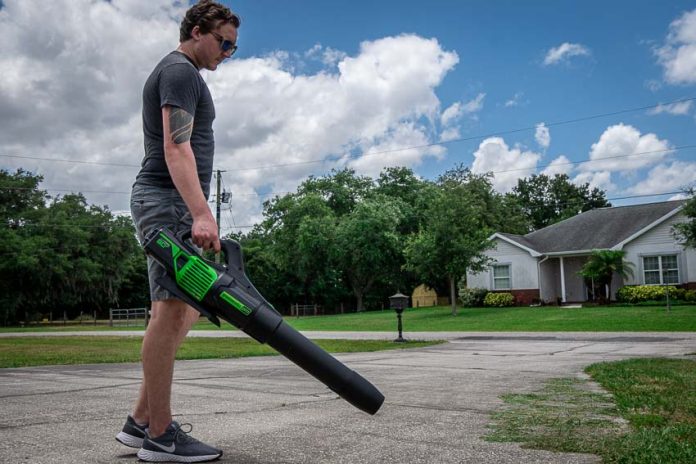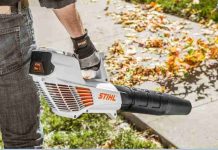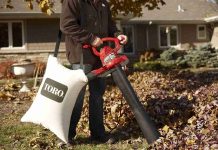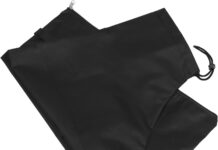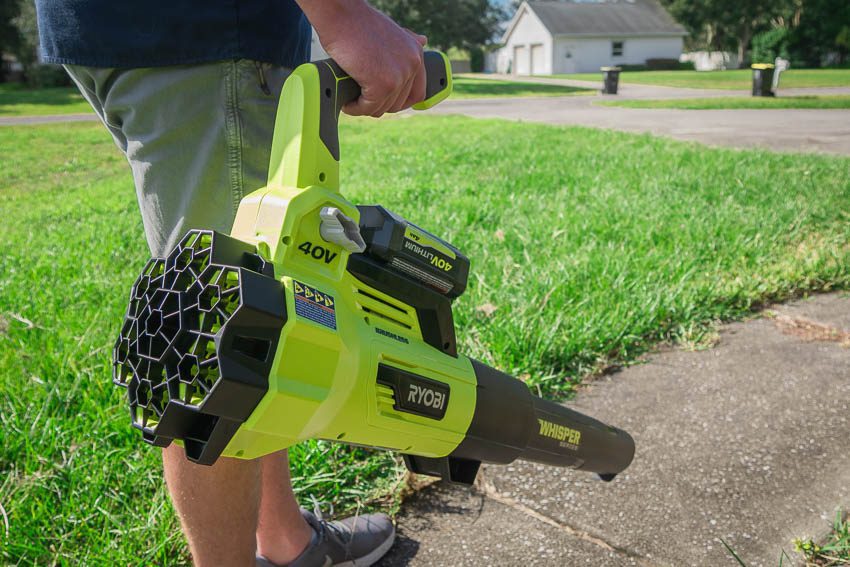When choosing the perfect leaf blower for your backyard, it’s essential to consider the performance factors that truly matter. This article explores the age-old question: is CFM or MPH more critical in a leaf blower?
While both measurements are crucial in determining a leaf blower’s effectiveness, understanding which one takes precedence can make all the difference in achieving pristine, leaf-free results.
Join us as we unravel the science behind CFM and mph, empowering you to make an informed decision and revolutionize your leaf-clearing game.
CFM: The Importance of Airflow
What is CFM?
CFM stands for Cubic Feet per Minute, measuring the air volume that a leaf blower can move in one minute. In simpler terms, CFM indicates how much air is being pushed out of the blower’s nozzle. The higher the CFM, the more air the leaf blower can move, resulting in better airflow.
How does CFM affect leaf-blowing efficiency?
CFM plays a crucial role in determining the efficiency of a leaf blower. When clearing leaves and debris, a higher CFM means the blower can generate a more potent air force to move the materials effectively. It allows the blower to cover a larger area and quickly remove debris. Therefore, the CFM rating directly impacts the performance and effectiveness of the leaf blower.
Factors affecting CFM
Several factors influence the CFM of a leaf blower. The design of the blower’s impeller, the shape and size of the blower’s nozzle, and the power source all contribute to the CFM rating. A larger impeller and wider nozzle can produce a higher CFM, while a more powerful engine or motor enhances the blower’s ability to generate more excellent airflow.
Determining the appropriate CFM for your needs
When determining the ideal CFM for your leaf-blowing needs, consider the size of the area you’ll be cleaning and the type of debris you’ll remove. Larger spaces and denser debris may require a higher CFM to clear the area efficiently. Additionally, considering your physical capabilities and the noise and environmental factors can help you determine the appropriate CFM for a leaf blower.
MPH: The Importance of Air Speed
What is MPH?
MPH stands for Miles Per Hour and measures the speed at which the air is pushed out of the leaf blower’s nozzle. MPH indicates the velocity of the airflow generated by the blower. A higher MPH rating means the air is expelled faster, increasing blowing force.
How does MPH impact leaf-blowing performance?
The MPH rating directly affects the blowing force of a leaf blower. A higher MPH means the air can reach further distances and penetrate through layers of leaves or debris more effectively. It enables the blower to dislodge stubborn debris from certain surfaces and ensure a thorough cleanup. MPH is crucial when dealing with damp or heavy materials that require a more substantial, concentrated airflow.
Factors affecting MPH
Various factors contribute to the MPH rating of a leaf blower. The design of the blower’s nozzle, the engine or motor’s power output, and the device’s overall airflow efficiency influence the MPH generated. A narrower nozzle can help concentrate the airflow, resulting in higher MPH. Additionally, a more powerful motor or engine can increase the airspeed produced by the blower.
Determining the appropriate MPH for your needs
When considering the ideal MPH for your leaf-blowing needs, evaluating the surfaces you’ll be clearing and the type of debris you’ll be dealing with is essential. Surfaces with irregular shapes or hard-to-reach corners may benefit from higher MPH, allowing the airflow to reach and clean these areas effectively. Additionally, wet or tightly packed debris may require a higher MPH to dislodge and remove efficiently.
CFM vs. MPH: Understanding the Differences and Relationships
The relationship between CFM and MPH
While CFM and MPH contribute to a leaf blower’s overall performance, they measure different aspects of the airflow. CFM focuses on the volume of air being moved, while MPH emphasizes the speed at which the air is expelled. It’s important to understand that CFM and MPH work together to provide optimal clearing power for different types of debris and cleaning tasks.
When to prioritize CFM over MPH
Prioritizing CFM over MPH is beneficial when dealing with light and dry debris, such as leaves or grass clippings. The high volume of air moved by a higher CFM rating ensures efficient coverage of a larger area, making it easier to clear lightweight materials. CFM becomes particularly crucial when the debris is spread over an ample space, enabling quicker cleanup.
When to prioritize MPH over CFM
It is ideal to prioritize MPH over CFM when facing heavier or wetter materials, such as thick piles of wet leaves or compacted mud. The increased airspeed generated by a higher MPH rating allows for better penetration and dislodging power against these types of debris. MPH becomes especially important for areas requiring more concentrated blowing force or surfaces that are harder to clean.
Finding the right balance between CFM and MPH
Finding a balance between CFM and MPH that suits your specific needs is essential to maximize leaf-blowing efficiency. If you frequently encounter various debris types and sizes, opting for a leaf blower with a well-balanced CFM and MPH rating is recommended. This ensures that you have the versatility to handle different cleaning tasks effectively and efficiently.
Leaf Blowing Efficiency: CFM vs. MPH
Understanding the significance of CFM in leaf-blowing efficiency
CFM plays a vital role in the overall efficiency of leaf blowing. A higher CFM allows for better coverage and faster clearing of large areas. With a more substantial air being moved, the leaf blower can disperse leaves and debris quickly, making the cleanup process more efficient. CFM is particularly important when dealing with lightweight materials or when time is crucial.
Analyzing the impact of MPH on leaf-blowing efficiency
MPH significantly contributes to the leaf-blowing efficiency, especially when dealing with tougher debris. With a higher MPH, the leaf blower can generate a more vital blowing force, dislodging and removing heavy or damp materials more effectively. The increased airspeed ensures that the airflow can penetrate through layers of debris and reach areas that may be difficult to clean. MPH is particularly valuable when tackling stubborn or hard-to-move debris.
Considering the role of nozzle design in optimizing CFM and MPH
The design of the nozzle can significantly impact both CFM and MPH, influencing the leaf-blowing efficiency. A nozzle with a larger opening can enhance CFM, allowing for better coverage and dispersal of material. On the other hand, a narrower nozzle can concentrate the airflow, resulting in higher MPH and better dislodging power. Opting for a leaf blower with interchangeable nozzles provides versatility, allowing you to optimize CFM and MPH for various cleaning needs.
Practical Considerations for Choosing Between CFM and MPH
Assessing the size of your cleaning area
When deciding between CFM and MPH, consider the size of the area you’ll be cleaning. A higher CFM is beneficial for larger spaces, as it enables faster coverage and more efficient clearing. However, a higher MPH might be more critical if you primarily work in smaller or confined areas, providing more concentrated blowing force in a limited space.
Considering the debris types and density
The type and density of the debris you’ll be handling also play a significant role in your decision between CFM and MPH. Prioritizing a higher CFM will ensure efficient cleanup if you typically encounter lightweight materials like leaves, grass clippings, or dust. However, if you often deal with heavy, wet, or compacted debris, a higher MPH will be crucial to dislodge and remove the material effectively.
Evaluating your physical capabilities
Your physical capabilities should also be considered when choosing between CFM and MPH. If you prefer a lighter, more maneuverable leaf blower, you may opt for a higher CFM with a lower MPH. Conversely, if you require more blowing force to handle heavy debris, you may prioritize a higher MPH with a slightly lower CFM. Finding a balance between power and handling convenience is crucial to ensure comfortable and practical leaf blowing.
Weighing noise and environmental factors
Consider the noise levels and environmental impact associated with your leaf blower. Higher CFM ratings often result in louder operation, which may be a concern if you frequently use the leaf blower in residential areas. Gas-powered blowers tend to be noisier and emit exhaust fumes, while electric or battery-powered blowers offer quieter operation and reduced environmental impact. Balancing these factors with CFM and MPH requirements is essential for a satisfactory leaf-blowing experience.
Balancing cost and performance
The cost of the leaf blower is another practical consideration to keep in mind. Higher CFM and MPH ratings typically come with a higher price tag. Finding the right balance between the performance you require and your budget is essential. Consulting customer reviews and expert recommendations can help determine whether a specific leaf blower provides a suitable combination of CFM, MPH, and overall value.
Understanding CFM Ratings
Interpreting CFM ratings in leaf blowers
CFM ratings in leaf blowers indicate the volume of air the blower can move in one minute. Manufacturers measure CFM by conducting standardized tests to determine the blower’s maximum airflow capacity. When comparing CFM ratings between different models or brands, a higher CFM generally signifies greater blowing power and a more extensive coverage area.
Differentiating between peak and average CFM
It’s important to distinguish between peak CFM and average CFM when evaluating leaf blowers. Peak CFM refers to the maximum airflow capacity that the blower can achieve momentarily under ideal conditions. On the other hand, average CFM provides a more realistic measurement of the blower’s sustained airflow output during typical usage. Generally, it’s more advisable to consider average CFM ratings when assessing a leaf blower’s performance.
Evaluating the impact of CFM on runtime
CFM ratings can impact the runtime of a leaf blower, especially in battery-powered models. Higher CFM ratings often result in increased power consumption, which can reduce the overall runtime. Consider the duration of the cleaning tasks you typically perform and ensure that the CFM rating aligns with your expectations to avoid interruptions or the need for frequent battery recharge.
Considering the impact of attachments on CFM
Attachments and accessories can impact the CFM performance of a leaf blower. Some attachments, such as concentrator nozzles or extension tubes, may increase the velocity of the airflow, resulting in higher MPH. However, they can also restrict the airflow and reduce the CFM rating. When using attachments, it’s essential to consider the trade-off between improved blowing force and potential reduction in CFM.
Understanding MPH Ratings
Interpreting MPH ratings in leaf blowers
MPH ratings in leaf blowers measure the speed at which the air is expelled from the blower’s nozzle. Higher MPH indicates a faster airspeed, enabling the blower to dislodge and move debris effectively. When comparing MPH ratings between different models or brands, a higher MPH generally signifies greater blowing force and better performance against stubborn debris.
Differentiating between peak and average MPH
Similar to CFM, it is essential to differentiate between peak MPH and average MPH when evaluating leaf blowers. Peak MPH refers to the maximum airspeed that the blower can achieve momentarily under ideal conditions. Average MPH provides a more realistic measurement of the blower’s sustained airspeed during typical usage. While peak MPH may be impressive, it’s generally recommended to consider average MPH when assessing a leaf blower’s blowing force.
Examining the impact of MPH on leaf displacement
MPH directly influences the leaf displacement capabilities of a leaf blower. A higher MPH enables the blowing force to carry leaves and debris further, ensuring that they are effectively moved and cleared from the desired areas. Depending on the distances you need to cover and the force required to move debris, considering the MPH rating can help you select a leaf blower that meets your specific needs.
Considering the limitations of high MPH
While high MPH can be advantageous in certain situations, there are limitations. Extremely high MPH ratings may result in reduced control and increased debris scattering, making it harder to direct the airflow accurately. Additionally, very high airspeed can cause damage to delicate plants or surfaces. Balancing MPH and control is essential to ensure efficient and safe leaf blowing.
Trade-offs: Noise, Weight, and Power Source
Assessing noise levels of high CFM and MPH blowers
When opting for leaf blowers with high CFM and MPH ratings, it’s crucial to consider the associated noise levels. Typically, leaf blowers with higher CFM and MPH tend to produce more noise due to the increased power output. Gas-powered blowers are generally louder than electric or battery-powered alternatives. If you are using the blower in noise-sensitive areas, it may be necessary to prioritize lower noise levels, even if it means sacrificing some CFM or MPH performance.
Considering the weight implications of higher CFM and MPH
Higher CFM and MPH ratings can often increase weight due to the need for more robust motors or larger impellers. It’s essential to consider the weight of the leaf blower, especially if you’ll be using it for extended periods or have physical limitations. Opting for a more lightweight blower with a reasonable compromise on CFM and MPH may offer a better user experience and reduce fatigue.
Comparing gas-powered, corded electric, and battery-powered blowers
Leaf blowers come in various power sources, each with its advantages and considerations. Gas-powered blowers offer higher CFM and MPH, providing greater blowing force and versatility. However, they tend to be heavier, noisier and emit exhaust fumes. Corded electric blowers are quieter and lighter but have limitations on mobility due to the power cord. Battery-powered blowers offer portability, reduced noise, and environmental friendliness but may have lower CFM and MPH ratings. Consider your specific needs and preferences when deciding on the power source for your leaf blower.
Choosing the Right Leaf Blower for Your Needs
Understanding the purpose and size of the cleaning task
When selecting a leaf blower, it’s essential to consider the purpose and size of the cleaning task. Whether you’re clearing a small yard, a large garden, or a commercial property, understanding the scale of the job will help you determine the appropriate CFM and MPH requirements. Additionally, consider whether you’ll use the blower for occasional maintenance or frequent cleanup, which may impact the desired performance and durability.
Matching CFM and MPH to your specific requirements
You can determine the CFM and MPH that best match your needs by assessing the cleaning task, debris types, and working environment. A leaf blower with moderate CFM and MPH may be sufficient for light debris on a small property. However, a higher CFM and MPH rating will ensure efficient and effective cleanup if you frequently encounter heavier debris or handle large areas. Understanding your requirements allows for a more informed decision when choosing the suitable leaf blower.
Considering additional features and accessories
Leaf blowers often have additional features and accessories that enhance their performance and versatility. Some models offer variable speed settings, allowing you to adjust the CFM and MPH according to the cleaning task. Backpack-style designs distribute the weight more evenly for improved comfort during prolonged use. Interchangeable nozzles or attachments can provide flexibility in directing the airflow. Evaluate these features and accessories to find a leaf blower that aligns with your preferences and offers added convenience.
Reviewing customer feedback and expert recommendations
Before making a final decision, reviewing customer feedback and seeking expert recommendations is valuable. Customers’ experiences can provide insights into the reliability, durability, and overall satisfaction with different leaf blower models. Expert reviews and recommendations can offer valuable guidance based on extensive testing and comparison. By taking advantage of the experiences and expertise of others, you can make a well-informed choice when selecting a leaf blower.
Maintenance and Care to Maximize Performance
Regular cleaning and removal of debris
To maintain the performance and longevity of your leaf blower, it is crucial to clean and remove any accumulated debris regularly. Brush or scrape off leaves, grass clippings, and other materials from the exterior of the blower. Please pay attention to the air intake vents and ensure they are clear of obstructions. Cleaning the blower prevents clogs, enhances airflow, and optimizes efficiency.
Inspecting and replacing air filters
Regularly inspecting and replacing the air filter is essential for maintaining optimal performance. The air filter prevents dust and debris from entering the blower’s engine or motor, ensuring clean air intake. Over time, the air filter becomes clogged, restricting airflow and reducing performance. Follow the manufacturer’s guidelines for cleaning or replacing the air filter to maintain the blower’s efficiency, extend lifespan, and prevent engine or motor damage.
Checking and tightening all connections
To prevent air leaks and ensure proper functioning, regularly check and tighten all connections on your leaf blower. Inspect the nozzle, tubes, and other attachments for loose or damaged parts. Tighten any loose connections to avoid air loss or decreased blower performance. Inspecting and maintaining connections promotes efficient airflow and prevents potential issues during use.
Lubricating moving parts as necessary
To keep your leaf blower operating smoothly, lubricate the moving parts as necessary. Check the manufacturer’s guidelines to identify the parts requiring lubrication and the appropriate lubricant. Lubricating bearings, belts or any other moving components reduces friction, enhances performance, and prolongs the lifespan of the blower. Regular maintenance in this aspect ensures a more efficient and reliable leaf blower.
Proper storage and winterization
Proper storage and winterization are crucial to prevent damage and ensure its longevity when the leaf blower is not used. Clean any remaining debris from the blower and store it in a dry and protected area.
If using a gas-powered blower, follow the manufacturer’s instructions for winterization, including draining or stabilizing the fuel tank and adequately storing the blower to prevent fuel degradation and engine damage. Proper storage and winterization practices safeguard your leaf blower for long-term use and better performance.
In conclusion, CFM and MPH are essential when choosing a leaf blower. CFM determines the volume of air moved per minute, while MPH indicates the speed at which the air is expelled. The appropriate CFM and MPH rating depends on the cleaning area’s size, the debris type, and your specific requirements.
Finding the right balance between CFM and MPH, considering other practical factors such as noise levels, weight, power source, and maintenance needs, will help you select the ideal leaf blower that maximizes efficiency, performance, and user satisfaction.
Regular maintenance and care are essential for prolonging the lifespan and optimizing the performance of your leaf blower, ensuring it remains a reliable tool for all your leaf-blowing needs.

